Stages of Balding Crown: How to Fix It!
Balding at the crown is a common hair loss pattern that affects many people. It starts with thinning hair at the top of the head, which can progress to a noticeable bald spot over time. Spotting crown balding early and taking action can help slow or stop its progression.


We know how frustrating it can be to see your hair thinning. The good news is that there are effective ways to address this issue. From topical treatments like minoxidil to medical procedures and natural remedies, options are available to help you maintain a full head of hair.
Taking care of your overall health and adopting a hair-friendly lifestyle can also make a big difference. By eating a balanced diet, managing stress, and using gentle hair care products, you can support healthy hair growth and slow down the balding process.

Why choose Stages of Balding?
Stages of balding help us understand hair loss patterns and track progress over time. They give us a framework to assess the extent of hair thinning and guide treatment options.
Overview of the Norwood Scale and Ludwig Scale
The Norwood Scale tracks male pattern baldness in 7 stages. It focuses on hair loss at the hairline and crown. Stage 1 shows no balding, while stage 7 indicates extensive hair loss. The scale helps doctors assess how far balding has progressed.
The Ludwig Scale measures female pattern hair loss in 3 stages. It looks at thinning on the top and crown of the head. Stage 1 shows mild thinning, stage 2 moderate, and stage 3 severe. This scale is useful for tracking hair loss in women over time.
Both scales use visual references to make comparisons easier. They’re widely used by hair loss experts to classify and monitor balding.


Stages of Balding in Men

Male pattern baldness often starts with a receding hairline. The hair at the temples thins first, forming an M-shape. Next, the crown begins to thin. Over time, the bald spots may connect, leaving hair only on the sides and back.
Early stages can be subtle. You might notice more hair in the shower drain or on your pillow. Your part may look wider, or your scalp more visible when your hair is wet.
Later stages are more obvious. Large areas of the scalp become visible. The remaining hair may be finer and lighter in color.

Stage 1
This stage represents a normal hairline with no significant hair loss or recession.

Stage 2
The hairline begins to recede slightly, typically around the temples, forming an "M" shape. This is also known as an adult or mature hairline

Stage 3
Hair loss becomes more noticeable, with the hairline receding further to form a deeper "M" shape. This is considered the first stage of clinically significant balding.

Stage 3 Vertex
In this variation, the hairline remains at stage 2, but there is significant hair loss on the crown (vertex) of the head.
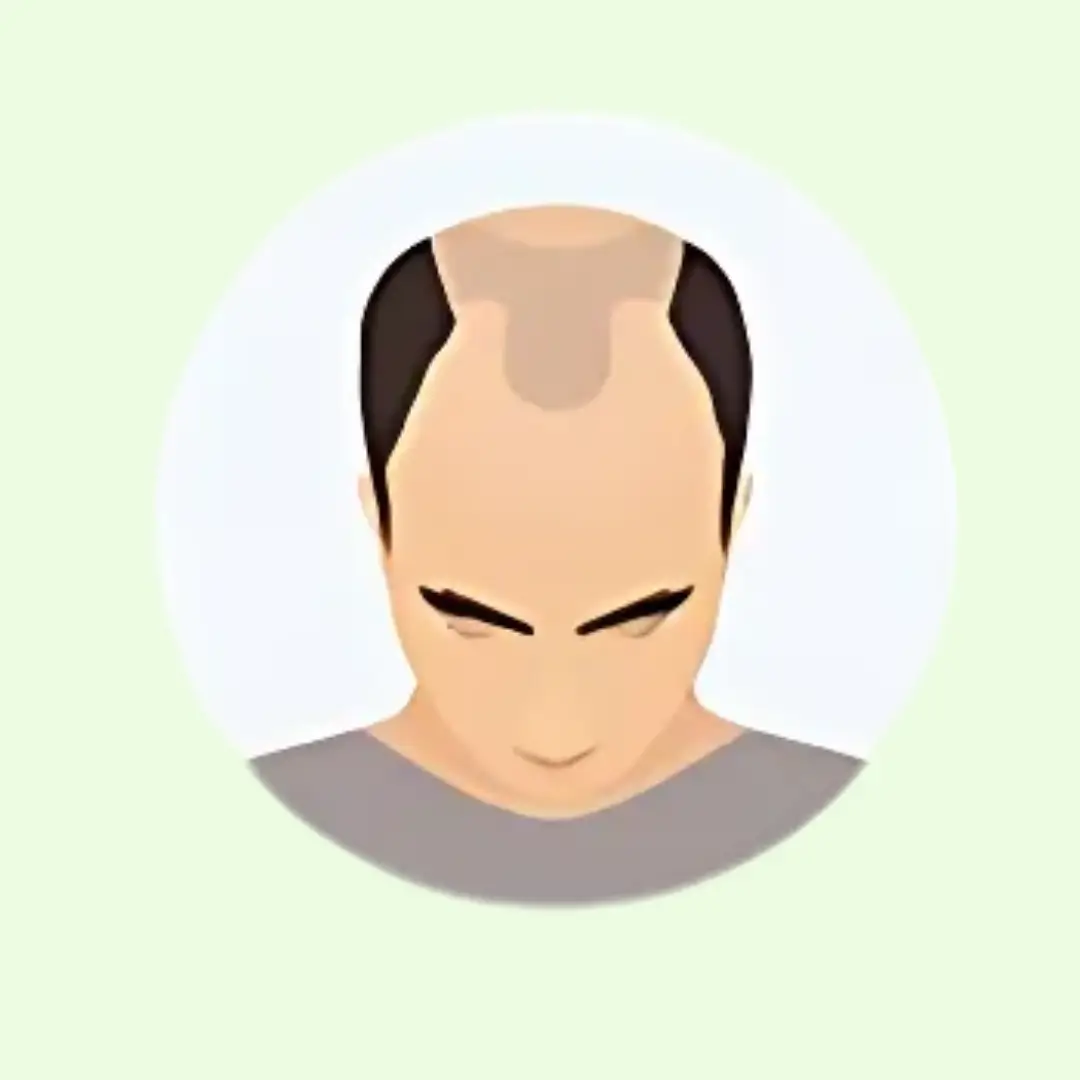
Stage 5
The bald areas at the temples and crown become larger, with only a thin band of hair separating them.
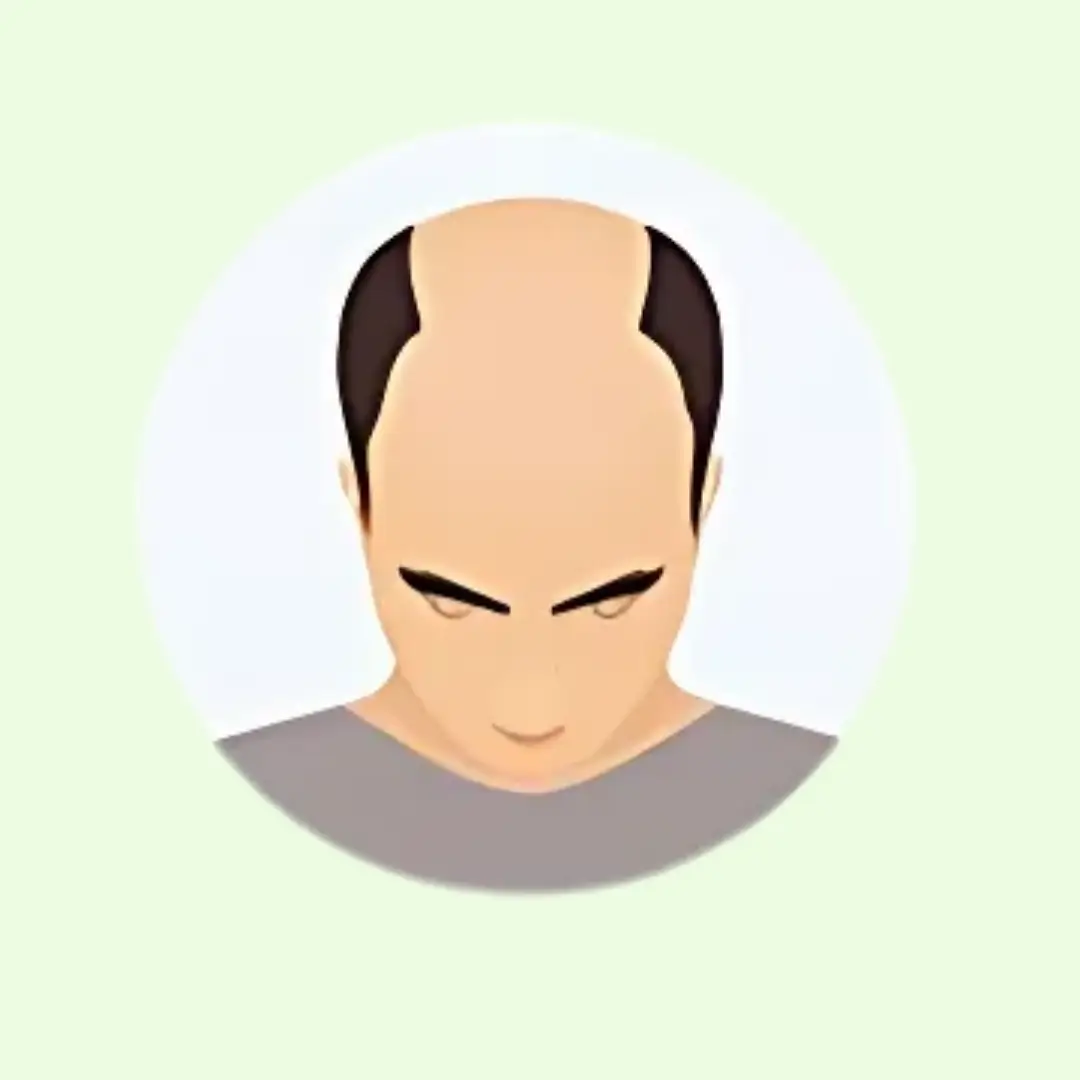
Stage 6
The balding areas at the temples join with the balding area at the vertex. The band of hair across the top of the head is gone or very sparse.

Stage 7
This is the most advanced stage of male pattern baldness. Only a narrow horseshoe-shaped band of hair remains on the sides and back of the head, while the top and front areas are extensively bald.
Stages of Hair Loss in Women
Women’s hair loss often looks different from men’s. It usually starts with overall thinning on the top of the head. The front hairline typically stays intact.
In early stages, you might see more scalp when parting your hair. Your ponytail may feel thinner. As thinning progresses, the part widens and more scalp becomes visible.
Severe cases can lead to significant hair loss on the crown. But total baldness is rare in women. Hair on the sides and back of the head usually stays thicker.
The Ludwig Scale measures female pattern hair loss in 3 stages. It looks at thinning on the top and crown of the head. Stage 1 shows mild thinning, stage 2 moderate, and stage 3 severe. This scale is useful for tracking hair loss in women over time.
Both scales use visual references to make comparisons easier. They’re widely used by hair loss experts to classify and monitor balding.

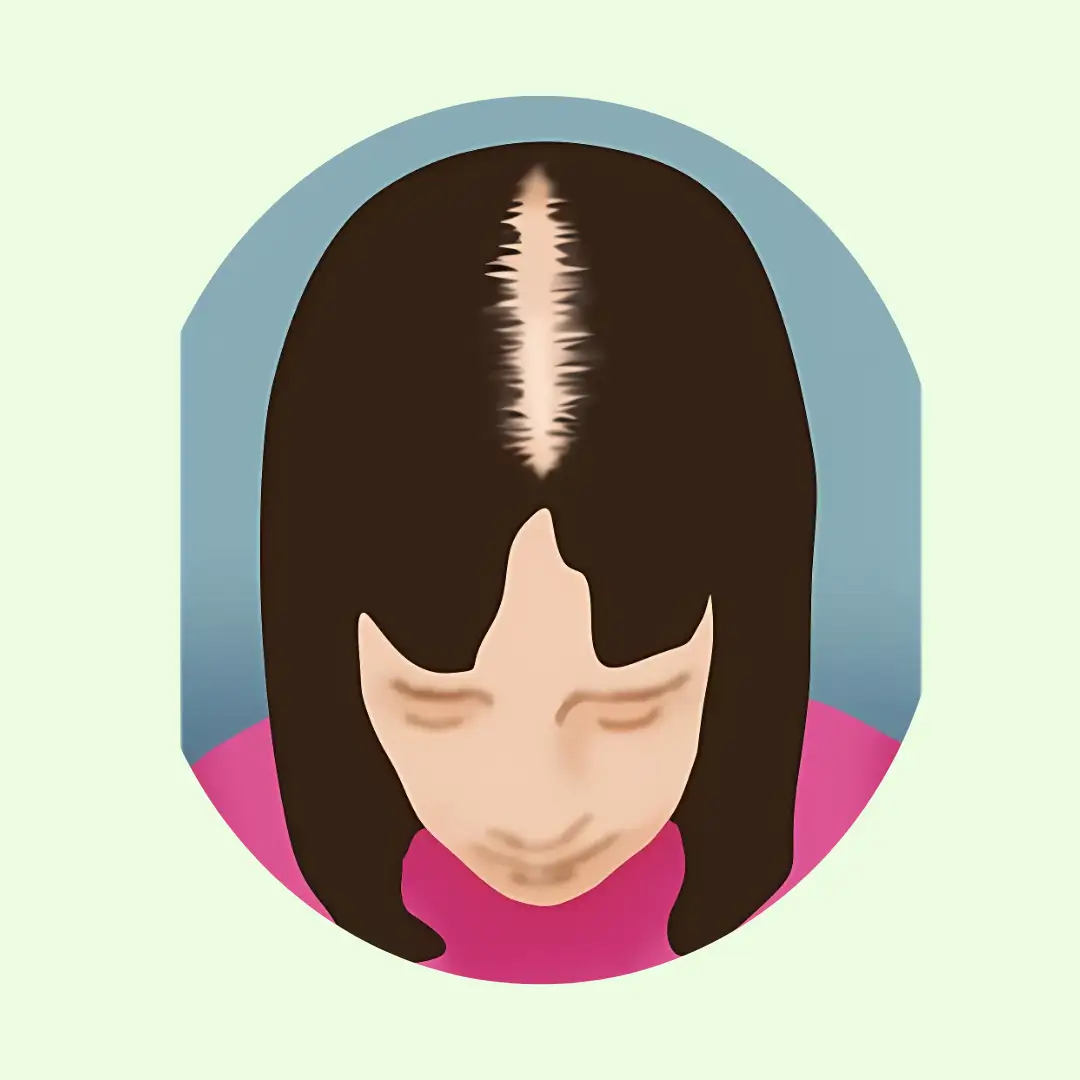
Stages I
Minimal thinning of hair around the center part. Hair loss is often barely noticeable at this stage.
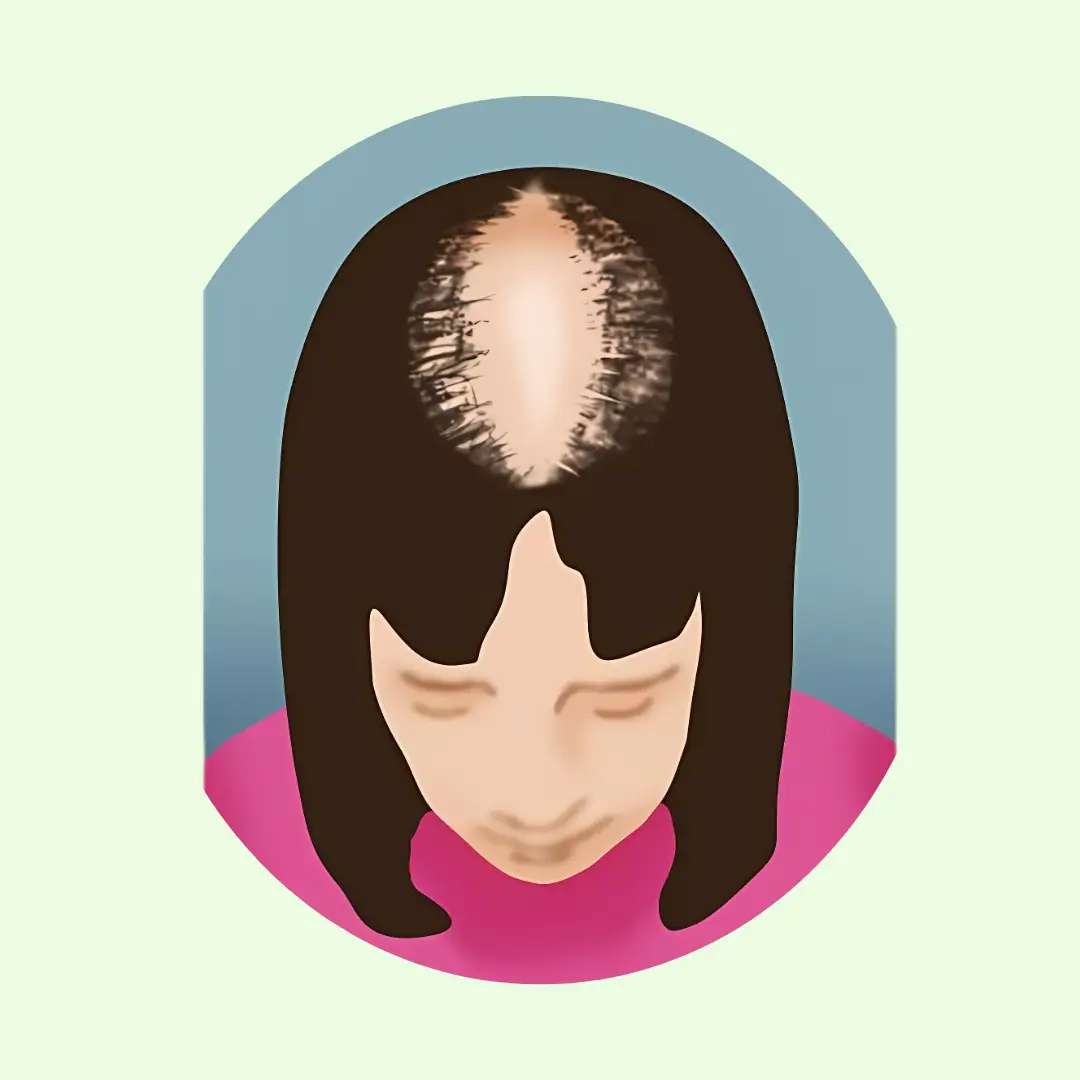
Stages II
Increased thinning and widening of the center part. Decreased volume becomes more apparent
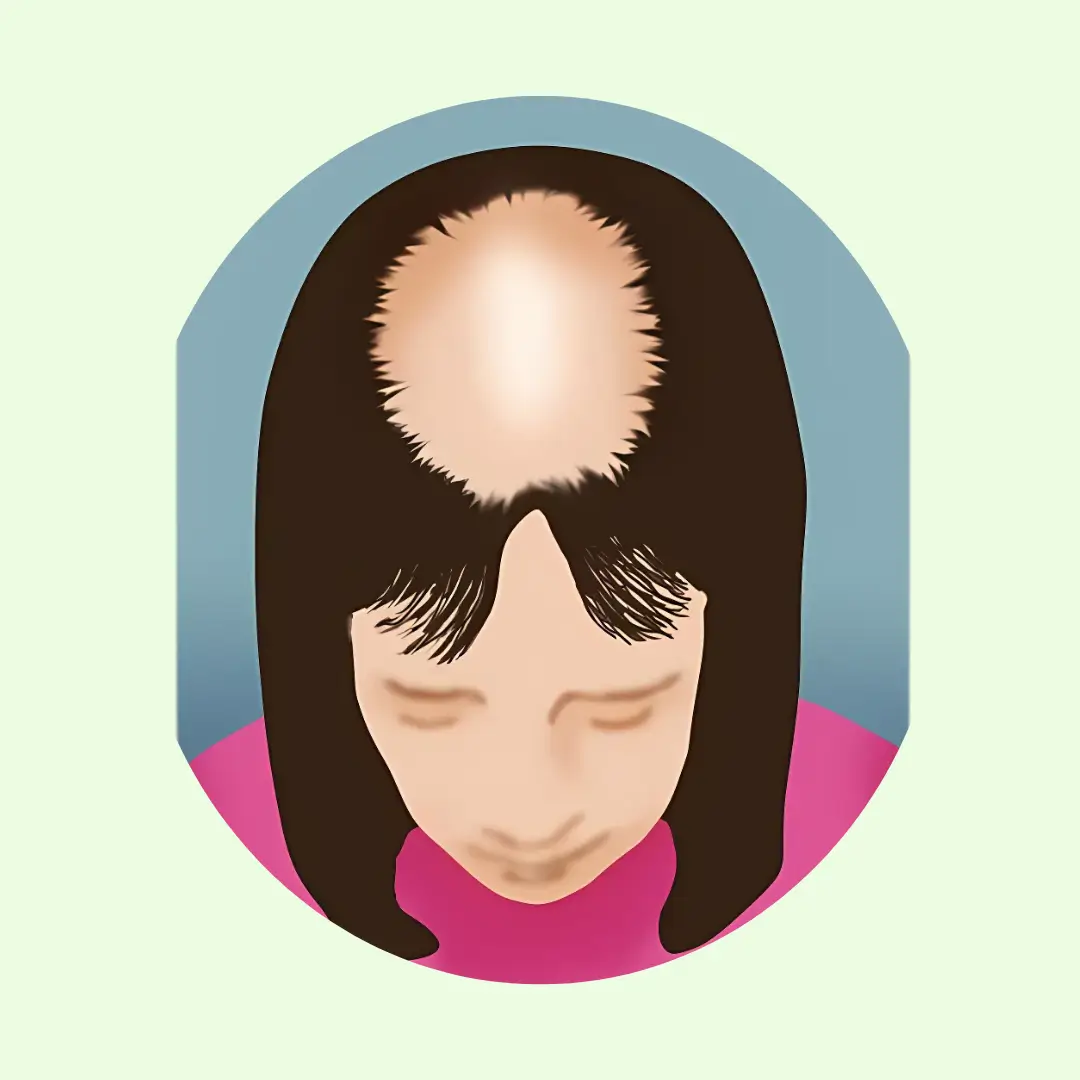
Stages III
Hair loss becomes more noticeable, with the hairline receding further to form a deeper "M" shape. This is considered the first stage of clinically significant balding.
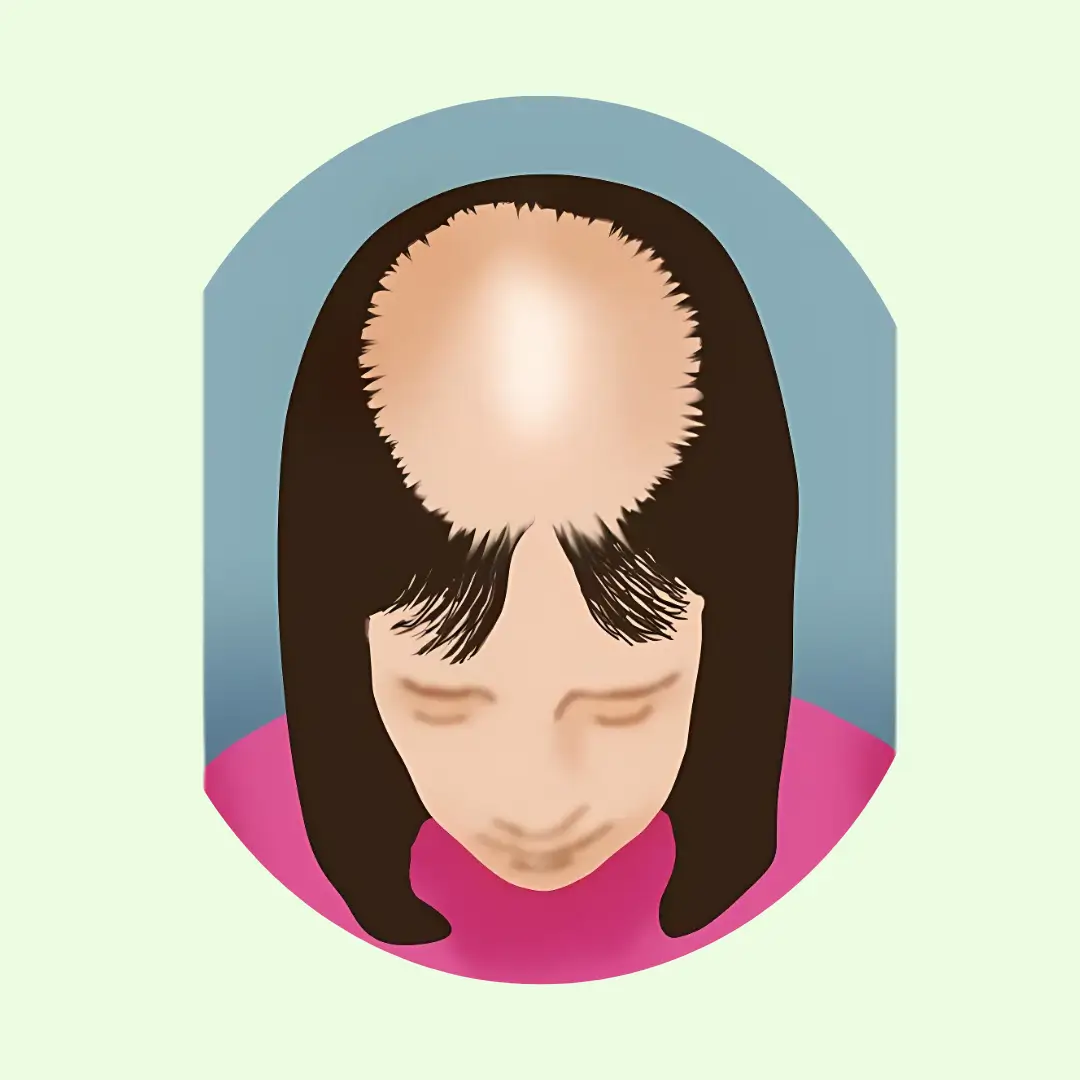
Advanced
Rarely seen clinically. There is almost complete hair loss on the crown and top of the head.

Importance of Understanding Crown Balding
Crown balding can greatly impact a person’s appearance and self-esteem. Knowing its causes and how to spot it early can help people take action to slow or stop hair loss.
What is Crown Balding?
Crown balding happens when hair thins at the top of the head. It often starts as a small bald spot that gets bigger over time. This type of hair loss is different from a receding hairline. The crown is the area at the back of the top of the head.
Men and women can both experience crown balding. In men, it’s usually part of male pattern baldness. For women, it may show up as overall thinning on top of the head.
Crown balding can be hard to notice at first. We might not see the back of our heads often. That’s why it’s important to check regularly or ask someone else to look.
MinoxidiI

For Hair loss stages 1,2 & 3

Finasteride

For Hair loss stages 1,2 & 3

ScalpMed

For Hair loss stages 1,2 & 3

What Causes Hair Loss at the Crown?
The main cause of crown balding is a condition called androgenetic alopecia. This is a fancy name for pattern hair loss. It’s linked to genes and hormones.
A hormone called dihydrotestosterone (DHT) plays a big role. DHT can make hair follicles shrink over time. This leads to thinner, weaker hair that eventually stops growing.
Other factors can also cause or speed up crown balding:
- Age
- Stress
- Poor diet
- Some medical conditions
- Certain medications
Sometimes, more than one factor is at work. That’s why it’s key to talk to a doctor if we notice hair loss.


How Common is Balding at the Crown?
Crown balding is very common, especially in men. By age 50, about half of all men have some hair loss at the crown. For women, it’s less common but still affects many.
The risk goes up as we get older. But some people start losing hair at the crown in their 20s or 30s.
It’s not just an “old person” problem. Young adults can have crown balding too. This type of hair loss often runs in families.
We should remember that crown balding is a normal part of aging for many people. It doesn’t mean anything is wrong with our health. But if it bothers us, there are ways to treat it.
Identifying the Signs of Balding at the Crown
Balding at the crown often starts subtly. We can spot early signs by looking closely at hair density and growth patterns. Let’s explore how to recognize crown balding and when to get help.
What Are the Early Signs of Crown Balding?
Crown balding usually begins with gradual thinning. We might notice our hair feels less thick when we run our fingers through it. The part line may widen, especially at the back of the head.
Another sign is a small bald spot forming at the top of the head. This spot may grow larger over time. We might also see more scalp showing when our hair is wet or under bright lights.
Some people notice more hair falling out in the shower or on their pillow. While some hair loss is normal, a sudden increase can signal crown balding.


How Can You Assess Your Hair Density?
There are simple ways to check hair density at home:
- Compare current photos to older ones
- Use a handheld mirror to view the top of your head
- Part your hair in different spots to check scalp visibility
- Count hairs lost after washing or brushing
For a more precise measure, try the “hair pull test”:
- Gently grasp about 50-60 hairs
- Pull slowly but firmly
- Check how many hairs come out
Losing more than 5-6 hairs may indicate thinning.
When Should You Seek Professional Help?
It’s best to see a doctor or hair specialist if:
- Hair loss happens suddenly or in patches
- We notice significant thinning or a growing bald spot
- Over-the-counter treatments don’t work after several months
- Hair loss causes stress or affects self-esteem
A professional can determine the cause of hair loss and suggest treatments. They might do blood tests to check for health issues linked to balding.
Early treatment often works best, so don’t wait if you’re worried about hair loss. A doctor can help create a plan to slow balding or regrow hair.


Effective Strategies to Stop Balding at the Crown
Crown balding can greatly impact a person’s appearance and self-esteem. Knowing its causes and how to spot it early can help people take action to slow or stop hair loss.
What Lifestyle Changes Can Help Prevent Hair Loss?
Stress reduction is crucial for preventing hair loss. We recommend trying meditation or yoga to lower stress levels. Regular exercise boosts blood flow to the scalp, which can help hair growth.
Getting enough sleep is also important. Aim for 7-9 hours per night to give your body time to repair and regenerate hair follicles.
Avoid tight hairstyles that pull on the scalp. These can cause traction alopecia, worsening crown balding.
Quit smoking if you do. Smoking restricts blood flow to the scalp, which can speed up hair loss.
Are There Specific Hair Care Products for Crown Balding?
Yes, there are products designed to help with crown balding. Look for shampoos and conditioners with ingredients like biotin, saw palmetto, and ketoconazole. These can help block DHT, a hormone linked to hair loss.
Minoxidil is a popular over-the-counter treatment. Apply it directly to the scalp twice daily to stimulate hair growth.
Hair thickening fibers can help cover up thinning areas temporarily. These are tiny fibers that stick to existing hair, making it look fuller.
Some people find success with scalp treatments like micro-needling or laser therapy. These can boost blood flow to the hair follicles.


What Role Does Nutrition Play in Hair Recovery?
A balanced diet is key for healthy hair growth. Protein is especially important, as hair is made mostly of protein. Aim for lean meats, fish, eggs, and plant-based proteins.
Iron deficiency can cause hair loss. Include iron-rich foods like spinach, lentils, and red meat in your diet.
Omega-3 fatty acids support scalp health. We suggest eating fatty fish like salmon or taking a fish oil supplement.
Vitamins A, C, and E are also crucial for hair health. Eat plenty of colorful fruits and vegetables to get these nutrients.
Biotin, a B vitamin, is often recommended for hair growth. You can find it in eggs, nuts, and whole grains.
Medical Treatments for Crown Balding
Several medical options can help fight hair loss at the crown. These treatments range from medications to surgical procedures, each with its own benefits and considerations.
What Are the Most Common Medical Treatments Available?
Minoxidil and finasteride are two popular treatments for crown balding. Minoxidil is a topical solution we apply to the scalp twice daily. It helps increase blood flow and can stimulate hair growth. Finasteride is a pill taken once a day. It works by blocking a hormone linked to hair loss.
We also have other options. Low-level laser therapy uses light to boost hair growth. Platelet-rich plasma (PRP) treatments involve injecting a concentrated form of your own blood into the scalp. This can help wake up dormant hair follicles.
Each treatment has different success rates. What works best can vary from person to person.
Kiierr Laser Cap - Clinically Proven

For Hair loss stages 2 & 3+

Irestore Laser Helmet

For Hair loss stages 2 & 3+

Theradome Laser Helmet
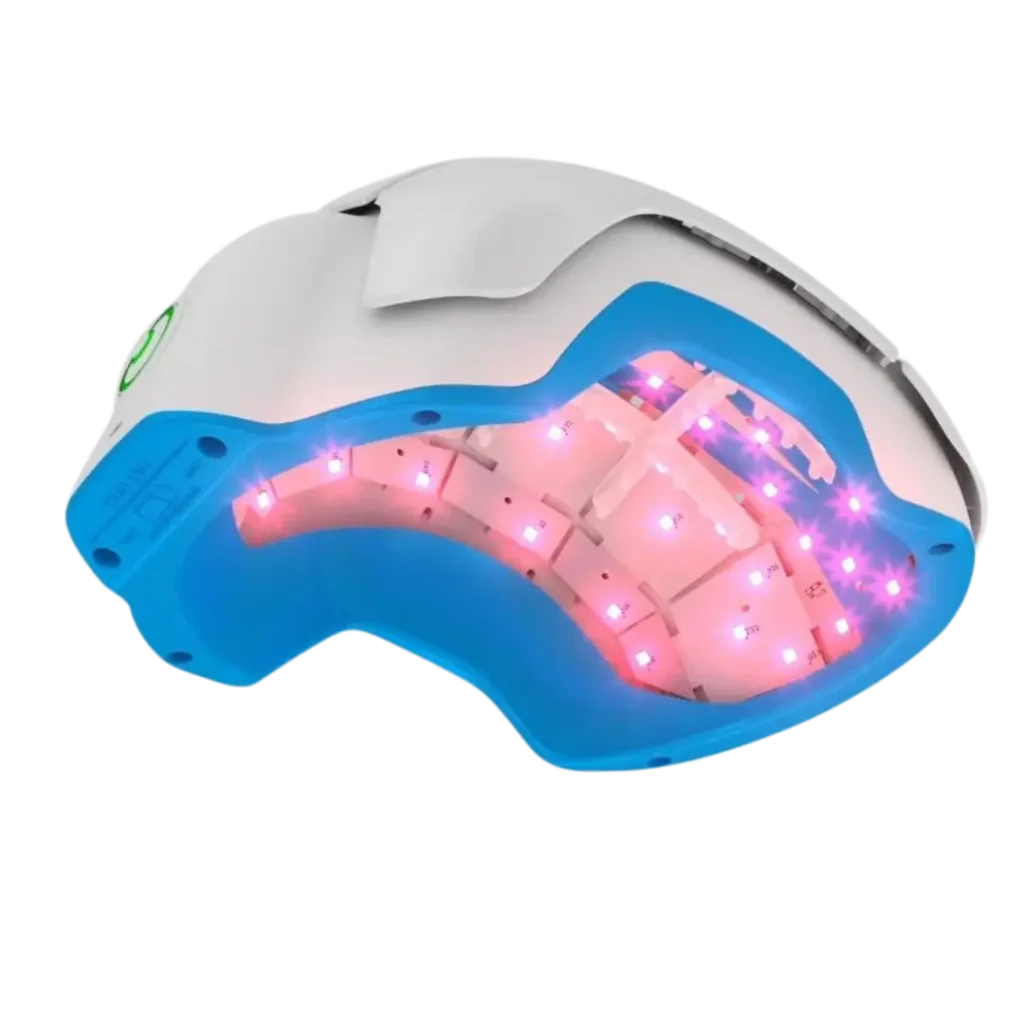
For Hair loss stages 2 & 3+


How Do Hair Transplants Work for Crown Balding?
Hair transplants move hair from areas with more growth to thinning spots on the crown. There are two main types:
- Follicular Unit Transplantation (FUT)
- Follicular Unit Extraction (FUE)
In FUT, we remove a strip of scalp and separate it into tiny grafts. With FUE, we take out individual hair follicles one by one. We then plant these hairs in the balding areas.
The procedure can take several hours. Results start to show after a few months. Full growth often takes about a year.
Are There Any Risks Involved with Medical Treatments?
Most treatments carry some risks. With minoxidil, some people might see scalp irritation or unwanted hair growth in other areas. Finasteride can cause sexual side effects in a small number of men.
Hair transplants can lead to infection or scarring if not done properly. There’s also a chance the transplanted hair might not grow as expected.
It’s crucial to talk with a doctor before starting any treatment. They can help weigh the pros and cons based on your specific situation. Regular check-ups during treatment can catch any issues early.

Natural Remedies for Hair Loss Recovery
Many people turn to natural solutions to address hair loss at the crown. These methods can be gentle and affordable options to try at home. Let’s explore some popular natural remedies for hair regrowth.
What Natural Ingredients Can Promote Hair Growth?
Several natural ingredients show promise for hair growth. Coconut oil can help prevent hair loss by protecting the hair shaft. We recommend massaging warm coconut oil into your scalp a few times a week. Onion juice is another option. It may boost circulation when applied to the scalp for 15 minutes before shampooing.
Rosemary oil is gaining popularity for its potential to improve hair thickness. Mix a few drops with a carrier oil and massage it into your scalp. Some people also use aloe vera gel directly on thinning areas to soothe the scalp and promote healthy hair growth.
How Effective Are Home Remedies for Crown Balding?
Home remedies can be helpful, but results vary. Some people see improvements in hair thickness and reduced shedding with consistent use. Others may not notice big changes. These methods often work best for mild to moderate hair loss.
Natural remedies are generally safe to try. They may work well alongside other treatments prescribed by a doctor. It’s important to be patient, as natural approaches can take months to show results. If you don’t see changes after 3-6 months, it might be time to explore other options.


Can Scalp Massage Help with Hair Recovery?
Scalp massage is a simple way to potentially boost hair growth. It increases blood flow to hair follicles, which may help nourish them. We suggest massaging your scalp for 5-10 minutes daily using your fingertips. Apply gentle pressure and use circular motions.
You can do this with or without oil. Some people prefer to use a hair growth oil or serum for added benefits. Regular scalp massage may also reduce stress, which is linked to some types of hair loss. While not a cure-all, many find it a relaxing addition to their hair care routine.
Maintaining Hair Health After Recovery
Keeping your hair healthy after treating crown balding takes ongoing effort and care. Let’s look at key practices, monitoring methods, and support options to help maintain your regrowth.
What Practices Should You Adopt to Maintain Hair Growth?
We recommend a balanced diet rich in protein, vitamins, and minerals to nourish your hair. Eat foods like eggs, fish, nuts, and leafy greens. Stay hydrated by drinking plenty of water each day.
Be gentle when washing and styling your hair. Use a mild shampoo and avoid harsh treatments. Pat your hair dry with a soft towel instead of rubbing.
Protect your scalp from sun damage. Wear a hat or use hair products with SPF when outdoors for long periods.
Reduce stress through exercise, meditation, or other relaxation techniques. High stress can impact hair health.
Get regular trims to keep your hair looking neat and remove split ends.


How Can You Monitor Changes in Hair Health Over Time?
Take photos of your crown area each month to track progress. Use the same lighting and camera angle for accurate comparisons.
Keep a hair diary. Note any changes in texture, thickness, or shedding. Record your diet, stress levels, and hair care routine.
Check your pillow and brush for excess hair loss. Some shedding is normal, but watch for increases.
Feel your hair’s texture regularly. Healthy hair should feel smooth and strong.
Schedule check-ups with your doctor or hair specialist. They can assess your scalp and hair follicles up close.
What Support Systems Are Available for Ongoing Hair Loss Management?
Join online forums or support groups for people dealing with hair loss. Sharing experiences can provide emotional support and practical tips.
Consider working with a trichologist. These hair and scalp specialists can offer personalized advice and treatments.
Look into hair toppers or wigs if you need extra coverage. Many stylish options are available for thinning crowns.
Talk to a therapist if hair loss affects your self-esteem. They can help you cope with the emotional impact.
Stay in touch with your doctor. They can adjust treatments if needed and address any new concerns.

Frequently Asked Questions
Crown balding affects many people. We’ll answer common questions about spotting early signs, treatment options, and ways to manage thinning hair.
What are early signs of hair thinning at the crown for both males and females?
Early signs of crown balding include more visible scalp when hair is wet or under bright light. You may notice wider hair parts or a small bald spot at the top of your head. Increased hair shedding and a thinner ponytail can also be warning signs.
What are effective treatments for balding at the crown?
Minoxidil is a popular over-the-counter treatment for crown balding. It's applied directly to the scalp. Prescription medications like finasteride can also help slow hair loss. For more advanced cases, hair transplants may be an option.
How can someone differentiate between normal hair parting at the crown and balding?
Normal hair partings are typically narrow and even. Balding at the crown often shows a wider, more irregular parting. The scalp may be more visible, and the hair around the part may look thinner. If you're unsure, a dermatologist can help determine if it's normal parting or hair loss.
What are the stages of crown balding?
Crown balding often starts with slight thinning at the top of the head. It progresses to a small bald spot that grows larger over time. In later stages, the bald area may merge with receding hair at the temples, leaving hair only on the sides and back of the head.
How can individuals naturally encourage regrowth in the crown area?
A healthy diet rich in protein, vitamins, and minerals can support hair growth. Scalp massages may improve blood flow to hair follicles. Reducing stress and getting enough sleep can also help. Natural oils like rosemary or peppermint oil might stimulate hair growth when applied to the scalp.
Are there any styling tips or techniques to conceal thinning in the crown?
Shorter haircuts can make thinning less noticeable. Styling products that add volume can help cover the scalp. Hair fibers or powders can temporarily disguise thin areas. For some, changing the hair part or using a comb-over style may help hide thinning at the crown.
Just give it a try
Stages of Balding

Nourishes scalp, prevents further thinning.
Stimulates follicles, encourages thicker growth.
Strengthens existing hair, promotes regrowth.
- FREE Shipping

Stages of Balding

Nourishes scalp, prevents further thinning.
Stimulates follicles, encourages thicker growth.
Strengthens existing hair, promotes regrowth.
- FREE Shipping

Stages of Balding

Nourishes scalp, prevents further thinning.
Reduces breakage and frizz, maintaining hair density
Deeply nourishes scalp, slows down hair loss.
- FREE Shipping

Scientific References:

